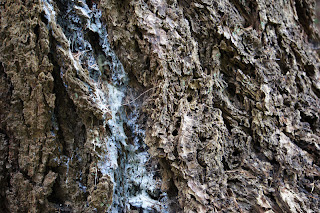This has given me a baseline for the ecology of the region.
Your bird watching will also improve immensely when you note the trees where the birds were found. Writing in your field journal, "I saw a Purple Finch calling," doesn't say much. How about, "Purple Finch made alarm calls 5 meters up the Red Cedar in the back yard. He flies down, out-of-sight." Now check your journal for past entries where Purple Finches appear. You'll get a better idea where to find them in the future. (Also check for the local Sharp-Shinned Hawk that scared the finch.)
Here is a little quiz. See if you can identify the trees by their bark. Answers will be at the end of the blog.
1. Hint - Found in California
2. Northwest Native
3. Northwest Native
4. Northwest Native
5. European Origin
6. Northwest Native; favorite of lumber industry
7. Northwest Native, traditional tree of the Salish Peoples
8. Northwest Native
9. Northwest Native
10. Northwest Native, a pioneer species
Hopefully you had some fun and the clues helped.
Answers: 1. Coastal Redwood (Sequoia sempervirens) 2. Black Cottonwood (Populus trichocarpa) 3. Paper Birch (Betula papyrifera) 4. Sitka Spruce (Picea sitchensis 5. Hawthorn (Crataegus oxyacantha) 6. Douglas Fir (Pseudotsuga menziesii) 7. Red Cedar (Thuja plicata) 8. Big-Leaf Maple (Acer macrophyllum) 9. Western Hemlock (Tsuga heterophylla) 10. Red Alder (Alnus rubra)










